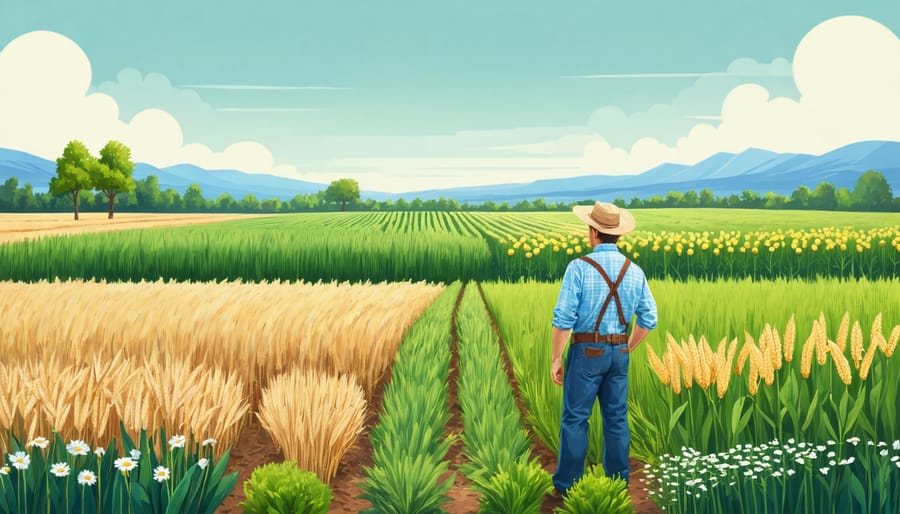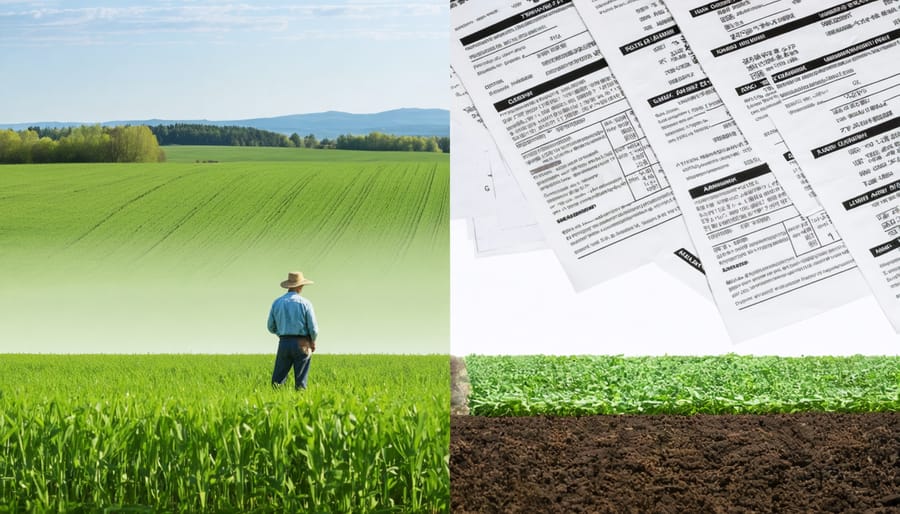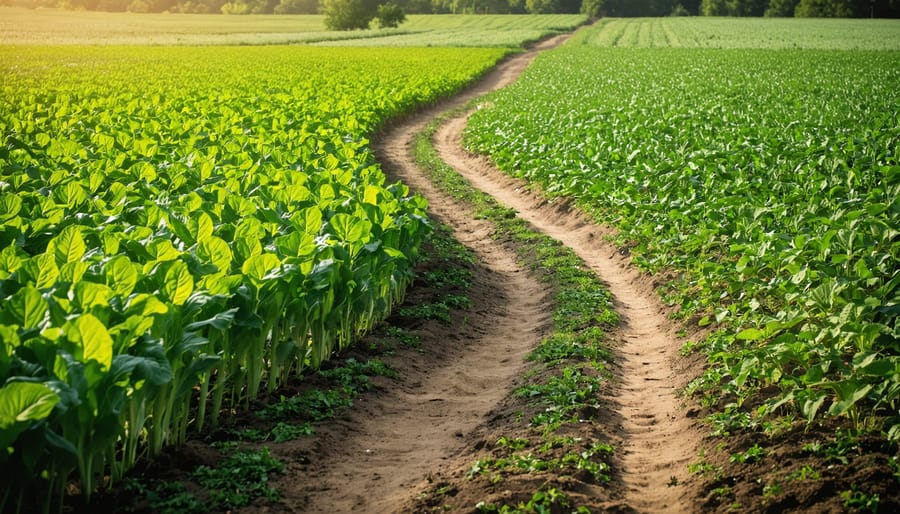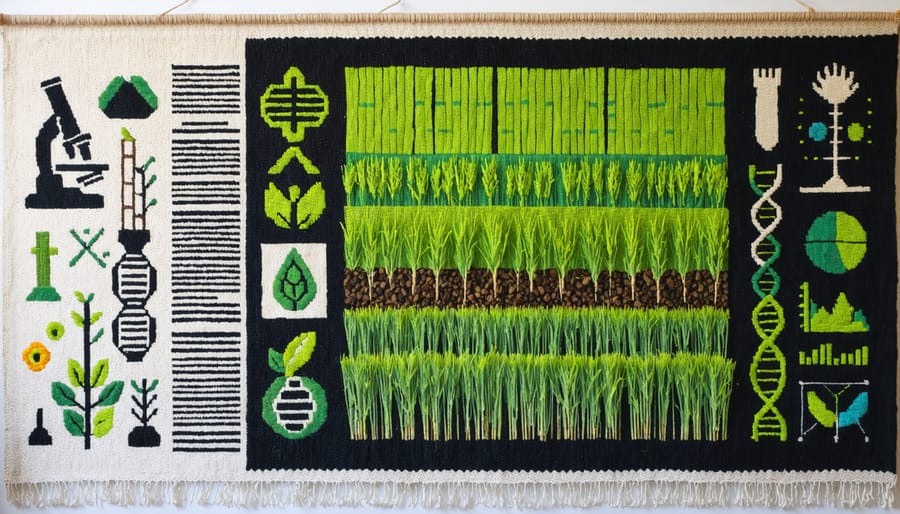Conduct a comprehensive carbon audit to identify your farm’s biggest emission sources and opportunities for reduction. Implement no-till farming practices to minimize soil disturbance, reduce fuel consumption, and increase carbon sequestration. Optimize fertilizer management by using precision application techniques, split applications, and slow-release formulations to minimize nitrous oxide emissions. Plant cover crops to combat climate change by improving soil health, reducing erosion, and sequestering carbon during off-seasons.
Assessing Your Farm’s Carbon Footprint
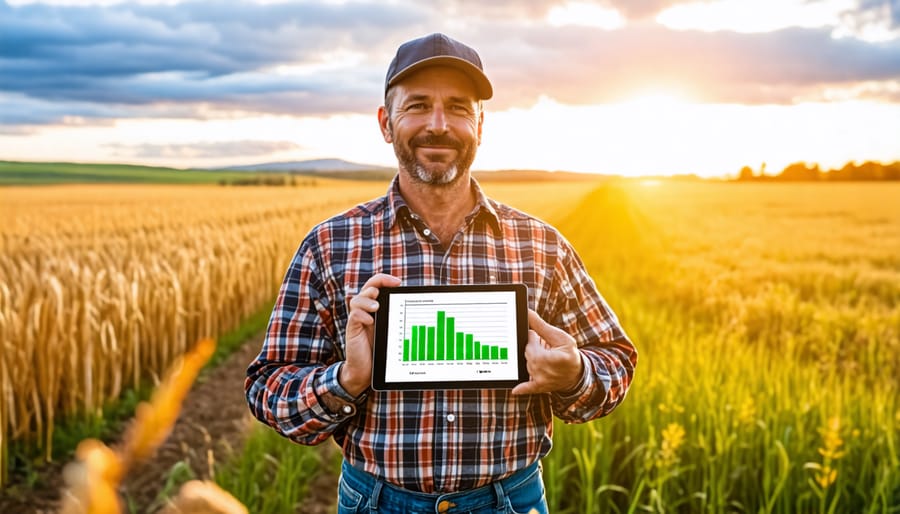
Carbon Audit Checklist
To conduct a carbon audit on your farm, follow these steps:
1. Define the scope of your audit, including which operations and facilities to assess.
2. Gather data on direct emissions from fuel and electricity consumption, as well as indirect emissions from inputs like fertilizers and feed.
3. Calculate emissions using standardized conversion factors, considering both carbon dioxide and other greenhouse gases like methane and nitrous oxide.
4. Analyze results to identify high-emission areas and potential reduction strategies.
5. Set measurable targets for emission reductions and develop an action plan.
6. Engage staff and stakeholders in implementing changes and tracking progress.
7. Consider partnering with carbon offset programs or sustainability certifications to validate your efforts.
8. Regularly review and update your audit to ensure continuous improvement over time.
By quantifying your farm’s carbon footprint, you can make informed decisions to minimize environmental impact while potentially accessing new market opportunities and cost savings.
Interpreting the Results
Interpreting your carbon audit results is a critical step in identifying areas where you can reduce emissions and improve sustainability on your farm. The audit will provide a breakdown of your farm’s carbon footprint across different activities, such as tillage, fertilizer use, livestock management, and energy consumption. Look for the main sources of emissions and consider how you can modify practices to minimize them.
For example, if tillage is a significant contributor, transitioning to no-till or reduced tillage methods could make a substantial difference. If fertilizer use is high, implementing precision application techniques or using slow-release formulas may help. Livestock emissions can be reduced through feed optimization and manure management strategies.
The audit will also highlight opportunities for carbon sequestration, like increasing soil organic matter through cover cropping or incorporating crop residues. Comparing your results to industry benchmarks and other farms in your region can provide valuable context for understanding your performance and setting realistic improvement goals. Remember, even small changes can add up to meaningful reductions over time, benefiting both the environment and your bottom line.
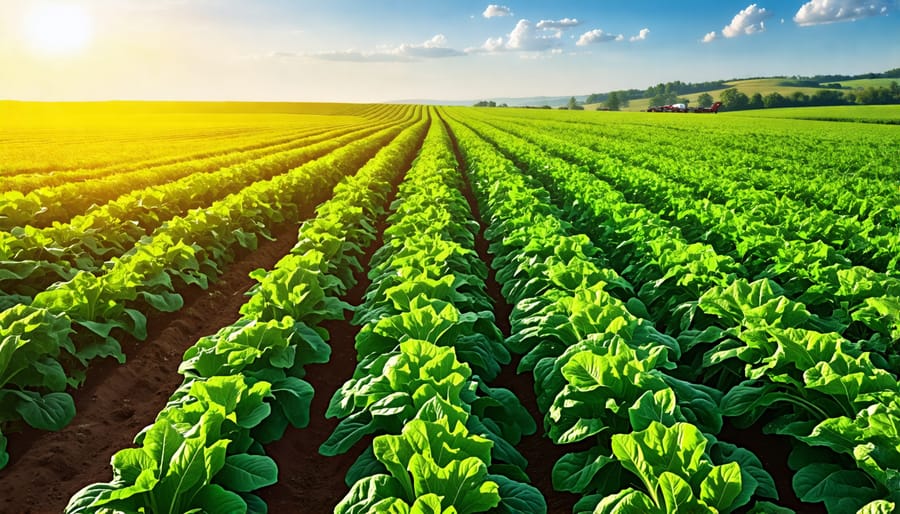
Implementing No-Till Farming
No-till farming is a game-changing agricultural practice that offers significant benefits for soil health and carbon sequestration. By minimizing soil disturbance, no-till farming helps preserve soil structure, increase organic matter, and reduce erosion. This approach promotes the growth of beneficial soil microorganisms, enhances water retention, and improves nutrient cycling. As a result, no-till farming not only boosts crop productivity but also plays a crucial role in mitigating climate change by sequestering carbon in the soil.
Alberta farmers have been at the forefront of adopting no-till practices, with many success stories to share. For instance, John and Sarah Thompson, who operate a 2,000-acre farm near Lethbridge, have been practicing no-till for over a decade. They have observed a significant improvement in their soil’s health, with increased earthworm activity and better water infiltration. The Thompsons have also reported higher yields and reduced fuel costs, thanks to fewer passes over the field.
Another inspiring example is the Smith family, who run a 3,500-acre grain farm in the Peace River region. Since transitioning to no-till, they have seen a dramatic reduction in soil erosion and an increase in soil organic matter. The Smiths have also noticed improved crop resilience during dry spells, as the no-till system helps retain moisture in the soil. These success stories demonstrate the tangible benefits of no-till farming for Alberta farmers, both in terms of environmental sustainability and economic viability.
Optimizing Fertilizer Management
Nitrogen fertilizers are a significant source of agricultural greenhouse gas emissions, but Alberta farmers can reduce their carbon footprint by optimizing fertilizer management. One key strategy is to conduct regular soil tests to determine the precise nutrient needs of your crops. This allows for more targeted fertilizer application, reducing waste and excess runoff. Consider using precision agriculture technologies like variable rate applicators to apply fertilizer more efficiently.
Another approach is to adopt the 4R nutrient stewardship framework: applying the right source of fertilizer, at the right rate, at the right time, and in the right place. This can involve using slow-release or stabilized nitrogen fertilizers that minimize losses to the environment. Timing applications to coincide with peak crop demand and incorporating fertilizer into the soil can also boost efficiency.
Improving fertilizer efficiency often goes hand-in-hand with other sustainable practices. For example, planting cover crops and legumes can help fix nitrogen in the soil, reducing the need for synthetic fertilizers. Crop rotation and intercropping can also optimize nutrient cycling and soil health.
By implementing these strategies, Alberta farmers can not only cut emissions but also save on input costs and improve their bottom line. As Tom Johnston, a grain farmer near Edmonton, explains, “Since we started using variable rate technology and cover cropping, we’ve seen a 15% reduction in fertilizer use without compromising yields. It’s a win-win for the environment and our operation.”
Embracing Cover Crops and Crop Rotation
Cover crops and diverse crop rotations are powerful tools in a farmer’s arsenal to combat climate change while improving soil health and productivity. By planting cover crops like legumes, grasses, and brassicas between cash crop cycles, farmers can enhance soil organic matter, reduce erosion, and sequester carbon. Leguminous cover crops, such as clover and alfalfa, fix atmospheric nitrogen, reducing the need for synthetic fertilizers. This not only cuts greenhouse gas emissions but also improves soil fertility and structure.
Implementing diverse crop rotations, alternating between different crop families, disrupts pest and disease cycles, minimizing the reliance on pesticides. It also promotes a thriving soil microbial community, which enhances nutrient cycling and carbon storage. When combined with no-till practices, cover cropping and crop rotation create a synergistic effect, maximizing their environmental benefits.
To successfully integrate these practices, start by identifying the right cover crop mix for your soil type, climate, and production goals. Consider factors like nitrogen fixation, biomass production, and root structure. Experiment with different seeding rates and planting methods to optimize establishment and growth. Timing is crucial – aim to plant cover crops promptly after harvesting the main crop to maximize their growth before winter.
When designing crop rotations, consider the nutrient demands and pest susceptibility of each crop. Alternate between nitrogen-fixing legumes, nutrient-scavenging grasses, and broadleaf crops to maintain soil balance and fertility. Keep detailed records of your rotations to track long-term soil health improvements and adjust as needed.
By embracing cover crops and diverse rotations, Canadian farmers can play a vital role in mitigating climate change while enhancing the resilience and profitability of their operations. With dedication and innovation, we can build a more sustainable agricultural future for generations to come.

Harnessing Renewable Energy on the Farm
Farmers in Alberta are increasingly turning to renewable energy sources to power their operations and reduce their environmental impact. Solar, wind, and biomass energy offer viable alternatives to fossil fuels, helping farmers lower their carbon footprint and energy costs. Solar panels can be installed on farm buildings or unused land to generate electricity, while wind turbines harness the power of the prairies to produce clean energy. Biomass systems convert agricultural waste into heat and power, creating a closed-loop system that minimizes waste and emissions.
Government incentives and financing options make the transition to renewable energy more accessible for farmers. The Canadian Agricultural Partnership (CAP) provides funding for clean energy projects, while the Alberta Energy Efficiency Rebate Program offers rebates for solar installations. Many renewable energy companies also offer financing plans that allow farmers to spread the upfront costs over time, making the switch to clean energy more affordable.
Embracing renewable energy not only benefits the environment but also supports the long-term economic sustainability of farms. By reducing reliance on fossil fuels and generating their own clean energy, farmers can insulate themselves from fluctuating energy prices and create new revenue streams by selling excess power back to the grid. As more Alberta farmers adopt renewable energy, they are setting an example for sustainable agriculture practices and contributing to a cleaner, greener future for the province.
Conclusion
In conclusion, Alberta farmers have a unique opportunity to lead the way in climate-smart agriculture. By embracing strategies like carbon auditing, no-till farming, precision fertilizer application, cover cropping, and renewable energy adoption, they can reduce their carbon footprint, improve soil health, and enhance the resilience of their farms. These practices not only contribute to the fight against climate change but also offer potential economic benefits through increased efficiency, reduced inputs, and access to carbon credit markets.
The path to sustainable agriculture is not one that farmers must walk alone. Organizations like Organic Farming, The Canadian Way are here to provide support, resources, and guidance to help farmers navigate this transition. By working together and sharing knowledge, we can build a strong community of climate-conscious farmers who are committed to preserving our land for future generations.
We encourage all Alberta farmers to take the first step towards climate-smart agriculture by reaching out to Organic Farming, The Canadian Way. Our team of experts is ready to assist you in conducting carbon audits, developing personalized action plans, and connecting you with the resources and support you need to succeed. Together, we can make a lasting impact on the health of our planet and the vitality of our agricultural community.


